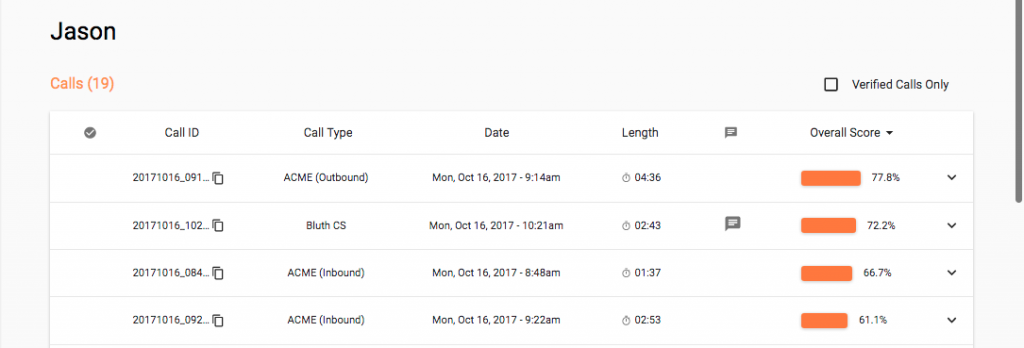The road to a customer purchase often consists of a phone call if your product isn’t bought based on impulse. Thankfully, in this day and age of information, our communication via phone can be tracked and analyzed.
With phone calls happening in higher volumes than ever before, recent advances in technology has allowed us to study every call that our businesses make. Modern marketing professionals have found a way to harness information gathered from phone calls in a way that significantly improves their sales conversions.
This groundbreaking system is none other than call analytics.
Call analytics makes use of AI and voice recognition technology to automate call transcription and collect call data. Then, presents the data according to useful metrics like call length, call type, first contact resolution, customer service score, etc.
What happens underneath the hood with the code and database management is pretty complicated, but a call analytics tool like VoxJar (see image below), can convert and distill raw call data into simple, easy-to-read, and actionable charts in seconds—no data science or software engineering required.

Photo borrowed from VoxJar
Every single phone call ever made to your business provides you with a vast wealth of data at your disposal. The challenge for any marketer is putting all that call data to work—there is no clear guide on how to utilize the data.
For those who have yet to master call analytics and the wonders that the technology can do for their businesses, we’ve prepared a list of tips and best practices. Read on, and see how many of them are applicable for your own operations.

Photo borrowed from: What’s Next – Nuance
1. Call Analytics Helps You Fine-Tune Your Customer Journey
Call analytics software allows you to track your site visitors’ activity before they even pick up the phone. This is thanks to call tracking: a digital technique that falls under the broader umbrella of
call analytics, and which is defined merely as a way of seeing which marketing channels (email, social, referral, etc.) drive the most calls to your business.
Call-tracking enables you to manage multiple referral phone numbers indicating the campaigns that lead to each phone call. For example, different numbers will be assigned for marketing channel. Because each of these channels are tagged with different phone numbers, you’ll be able to find out precisely which of your campaigns are effective in driving conversions and why they work so well.
The information gathered from call tracking, alongside call recordings and transcriptions, will pinpoint which aspects of your campaign are the strongest, and which parts need room for improvement. Use them when assessing which of your campaigns should continue, as well as when fine-tuning your marketing operations with A/B tests, in order to craft a visual and tonal journey for your audience that leads to higher conversions.

Photo borrowed from: wiseGEEK
2. Call Analytics Lets You Optimize Your Keyword Marketing
Another feature of call-tracking is that it lets you identify which keywords lead to more calls. Similar to how you can tag a marketing campaign with a specific phone number, you can have
custom phone numbers attached to specific keywords. If you’re marketing for a business that specializes in installing home security systems, for example, you can check to see whether “home security installation” drives more calls than “security system installation.”
From there, you can decide whether both keywords are worth spending on, or if it’s re-adjust your strategy. Carefully selecting each keyword helps build a cost-effective bidding strategy that
increases your chances of getting the most out of your ad spending budget. Since bidding on various keywords can be costly, knowing which keywords drive calls will enable you to focus on more cost-effective search terms. Not only do you save money, but you also have a clearer path towards improving not only your brand’s PPC (pay-per-click) performance but also its SEO (Search Engine Optimization) as well, leading to a higher ROI in the long run.
3. Focus Fire on Your Best Channels with Call Analytics
We’ve already touched on how custom numbers allow you to re-think your marketing strategies by referencing the performance of your different channels. But beyond helping you fine-tune your marketing activity, this also enables you to figure out which channels should be strengthened, and which ones should be dropped.
One of the tougher decisions that a marketer will have to make when referencing their call analytics data is whether to try and improve an underperforming channel or to drop it entirely. Our rule of thumb is simple: focus on marketing and sales alignment so that the leads your bringing in are qualified.
Also focusing on your top-performing marketing channels can leave you with lower opportunity costs than if you were to maintain channels that underperform. Instead of spreading out your resources to keep unnecessary channels, you can concentrate on those that generate sales and traffic. And as an added benefit to dropping your weakest channels, your creatives team will have more time and attention to devote to drawing up improved strategies for your top performers.

Photo borrowed from: Square
4. Call Analytics Enables Data-Driven Training
Keeping your staff in top shape is important. They’re at the front line of your business’ sales interactions, so it’s crucial for your staff to know who they’re talking to, how to deal with the different types of people they are talking to, and how to convert inquiries into purchases.
Luckily, call scoring lets your business rate and sort callers, giving you and your sales agents a more in-depth understanding of the kinds of people who are most likely to convert. More specifically, you are privy to information regarding you callers’ gender, household income, geographic location, etc. –all useful insights as you strive to improve your calling approaches.
Train your staff to scrutinize your caller demographics, to avoid the costly mistakes that come with having inadequate knowledge of your market segments. The effort that goes into examining your customers’ preferences will help your staff understand how to directly addresses and deal with the customers’ needs and wants, leading to higher customer retention and loyalty.
Conclusion
The benefits of knowing how to utilize data from call analytics properly are infinite. The only limit to how this new form of data-driven marketing can help your business is your willingness to master it. So track your calls and you’ll be surprised at how studying simple conversations can result in better customer service and improve your bottom line.











Comments